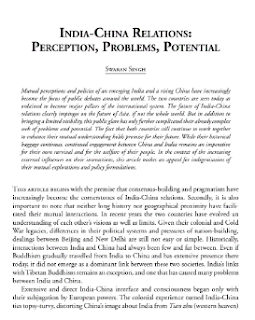Comparative study of India and China's Economy: Key Differences in Infrastructure, Education, Health
We examine how India and China differ in three crucial areas that affect long-term growth in this comparative analysis of the economies of China and India: Key Differences in Infrastructure, Education, and Health: Each country's capacity to use its demographic landscapes and drive economic advancement is influenced by advancements in infrastructure, educational programs, and health results. Let's examine the main differences.
1. Infrastructure: Coverage versus Connectivity China is notable for its significant investment in infrastructure, allocating over 9% of GDP to the construction of modern highways and the world's largest high-speed rail network (almost 45,000 km).
Even with improvements—including the largest road network in the world (6.6 million km) and programs like Bharatmala, Sagarmala, and PM Gati Shakti ($1.2T)—India still lags behind in terms of quality: urban congestion, rail density shortages, and highway delays continue.
2. Education: Enrollment & Literacy: Quantity vs. Quality
According to en.wikipedia.org, China boasts a 97% adult literacy rate, mandatory 9-year education, 60% gross enrollment in higher education, and more than 10 million vocational graduates annually.
India has a literacy rate of over 78%, a higher education gross enrollment rate of about 28.4%, and high student-teacher ratios.
Strategy for Human Capital
China developed its industrial capabilities by starting with mass basic education and moving on to vocational and university education.
India initially prioritized the growth of elite postsecondary education, falling behind in basic and vocational systems; quality is still inconsistent.
3. 🏥 Health: Emerging Reform versus System Maturity Mortality and Expectancy of Life
China has a life expectancy of about 77 years, a low infant mortality rate, and a strong public healthcare system.
India: Despite reform attempts, life expectancy is between 71 and 74 years, infant mortality is greater, and undernutrition (child stunting) is pervasive (around 3.5%).
Access to Healthcare
China is now tackling aging demands and rural gaps; legislative reforms are being implemented since more than 120 million rural elders do not receive timely care.
India prioritizes undernutrition initiatives, preventative measures, and digital health; nonetheless, access to rural areas and care for urban slums remain inadequate.
4. ⚙️ Why These Differences Matter Economic Efficiency: China's infrastructure and vocational education improved worker productivity and decreased transaction costs.
Demographic Leverage: In order to convert into economic advantages, India's youth require improved roadways, educational institutions, and healthcare facilities. Costlier elder care is required by China's aging population, which reduces the country's demographic dividend.
Summary Table
- CHINA: High-speed rail, modern highways, lush ports
- INDIA: Largest road network, multimodal plans, coastal upgrades
- CHINA: Near-universal literacy, vocational pipeline
- INDIA: Rapid expansion, rising budgets, digital youth
Health:
- CHINA: Longer lifespan, lower child mortality, rural reforms
- INDIA: Health campaigns, policy momentum, reform focus
Final Thoughts
What is the comparative study of India's and China's economies?
Why does China have better infrastructure than India?
What is the economic relationship between India and China?
In terms of economics, China is India's biggest trading partner; in the fiscal year 2023-2024, bilateral trade exceeded $100 billion. India still relies heavily on China for industrial goods, especially in the areas of electronics, machinery, and chemicals.













